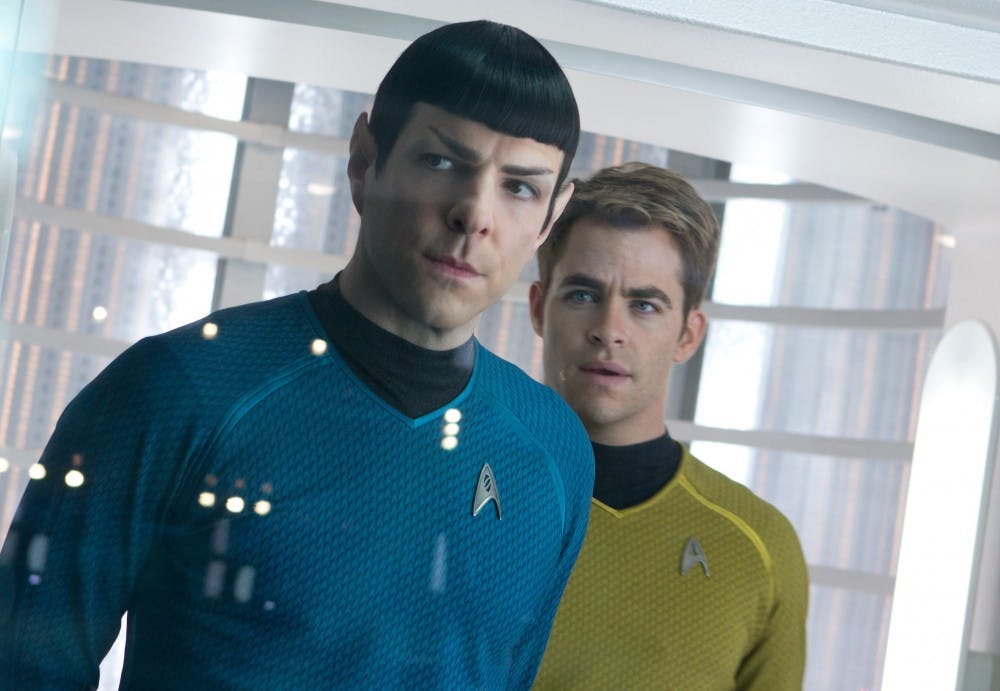"To boldly go where no man has gone before" might need an addendum: "To boldly go and blow things up in galaxies far, far away....where no man has gone before."
There is something very Spielberg-ian in the wells of J.J. Abrams' ("Lost") "Star Trek Into Darkness." The film begins as paper mache humanoids of the planet Nibiru are chasing Kirk (Chris Pine, "This Means War") and Dr. "Bones" McCoy (Karl Urban, "Dredd") with spears through a red forest right out of H.G. Well's mordant fantasies.
If this doesn't sound familiar, one only need to replace Pine with Harrison Ford to get a dystopian vision of Indiana Jones's famous escape from ticked-off natives.
The plot veers away to the cunning terrorist John Harrison (Benedict Cumberbatch, "Sherlock"), arising as the newest threat to the Starfleet Federation.
When Harrison wreaks havoc down on the steps of the Starfleet headquarters, he flees to the Klingon planet Kronos, where Kirk is sent by warmongering Admiral Marcus (Peter Weller, "Robocop") on a revenge mission with a mysterious payload of missiles and orders to kill Harrison.
"Star Trek Into Darkness" is viciously fast-paced, even thrilling at times, until you get the sense that Abrams is pulling tricks from another "Star"-focused franchise. From the warp scenes that usher in a familiar light show, to Kirk and company whizzing down tight corridors in a ship shaped like the Millenium Falcon, "Into Darkness" starts to aesthetically resemble "Star Wars Episode VI: Return of the Jedi."
Conceptually, most of the technology, sound effects and creature design would fit quite comfortably within George Lucas's galaxy. The experience feels like an elaborate overture for Abrams' upcoming "Star Wars" movie.
As to matters of the cast and plot, "Star Trek Into Darkness" is a taught nuts-and-bolts blockbuster, which busts everything from blocks to entire cities. The ensemble cast returns with fine performances, especially from the reptilian, brooding Cumberbatch. There are pleasures in watching the cast show an uncanny mimicry of the original crews' sensibilities
Abrams claims "Into Darkness" is a supposed reinvention of the original canon, but it still frustratingly fits itself snugly into plot movements of its parent films. "Into Darkness" regularly borrows from "The Wrath of Khan" to "The Undiscovered Country." "Inception" might even come up as Kirk and Scotty (Simon Pegg, "Paul") run through spinning sterile white hallways as the Enterprise tumbles down to Earth.
Its structure is intrinsically tied to those films and yet it comes across almost as pandering in the name of fan service. When it comes time for the bait-and-switch, audiences will already expect it.
The script is also heavy-handed in its foreshadowing. A specific plot point in the first moments of the film is developed with an absurd amount of specificity, so much so that it defeats the purpose of the third act drama.
The friendship between Capt. Kirk and Spock (Zachary Quinto, "Heroes") is comically blunt in its eroticism, occasionally overshadowing Uhura (Zoe Saldana, "The Words") and Spock's complex relationship. It certainly won't quell fan-fiction writers' claims of a relationship, or at the least a bromance, between the two.
Abrams continues the philosophical traditions of the original films. Imperialism, the ethics of preemptive strikes, the militarization of Starfleet and what it truly means to be human are all fair game in "Into Darkness." But they are staged as the crew of the Enterprise rush through space chased by a barrage of enemies.
The cinematography continues the vein of adding enough flashy lens flairs to make the Enterprise look as if it were a swanky nightclub. The script is filled with wit, though clogged with references to the original films. Nothing needs to be said about the visual effects other than they are remarkable eye candy.
The score by Michael Giacchino ("John Carter") is soaring and relentless, occasionally throwing knowing nods to other "Star Trek" composers such as Gerald Fried, Jerry Goldsmith and Alexander Courage.
Strangely enough, there seems to be a scarcity of space within the framing of the shots. Frequently, the tops of heads are lopped off in a scene, and the camera gets alarmingly up close to actors' faces and objects.
Perhaps reception to "Into Darkness" depends on what kind of fan will see it. But while narratively jumbled, this "Star Trek" is still a satisfactory experience, if only visually in 3D. The U.S.S. Enterprise and her crew never looked better.
dkahen-kashi@theeagleonline.com





